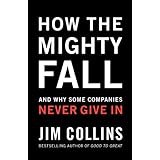
Average Reviews:

(More customer reviews)Let me preface this review by saying that I am a fan of Collins' earlier work. Built to Last was a great book, and Good to Great was very good. How the Mighty Fall, however, is neither. The issue of corporate failure is critical, particularly in the current downturn. Unfortunately, the core of Collins' analysis in this book is flawed.
How the Mighty Fall addresses two related questions: Why do good companies fail? and how does management respond once a company gets into trouble? Collins introduces a five stage model to answer these questions, where steps one and two address the roots of corporate failure and steps three through five managements' response.
Collins' analysis of management response to decline--denial of risk, grasping for salvation, and capitulation to irrelevance or death--accurately describe how leaders respond to deterioration in their business. This analysis here is solid, the writing clear, and the tempo brisk. Collins does a particularly good job of describing dysfunctional leadership behaviors of companies is in decline.
Collins' analysis of why companies get into trouble in the first place is much less compelling. Companies fail, according to Collins, when success breeds managerial hubris, which leads to overreach and ultimately failure. Like many of Collins' findings, this makes intuitive sense. Unfortunately in this case, his core argument runs counter to research on hundreds of companies, conducted over decades by dozens of scholars. There are two major flaws in Collins argument.
First, he claims that companies get into trouble because they overreach and expand beyond their core. This is consistent with data showing that diversified companies trade at a discount to focused rivals. Recent research published in the Journal of Financial Economics and the Journal of Finance has established that the companies often diversify to escape decline in their core business. Overreach is a symptom--not a cause--of decline and thus cannot explain its roots.
Second, Collins ignores a rich body of research that finds decline sets in not because companies stray from their core, but because they stick too close to it. Clay Christensen's research on disruptive technology, for example, demonstrates that companies stumble when they stay too close to their established customers and fail to serve emerging segments. The competency trap literature finds that companies get locked in by what they do well and struggle to adapt when circumstances change. Hubris and overreach, of course, play a role in corporate decline, but a well-established body of research suggests that they are rarely the root causes.
How did Collins, who does many things right in his research, get his core finding so wrong in this case? As always he tackles a big and important question, and his pairing of comparable companies is a sensible research design. His failure to read or acknowledge a rich body of previous research that bears directly on his research question, in this case, has led him to rather facile observations. In research, as in business, a lack of humility in recognizing the contributions of others can lead to overreach.
Click Here to see more reviews about: How The Mighty Fall: And Why Some Companies Never Give In
Decline can be avoided. Decline can be detected. Decline can be reversed.
Amidst the desolate landscape of fallen great companies, Jim Collins began to wonder: How do the mighty fall? Can decline be detected early and avoided? How far can a company fall before the path toward doom becomes inevitable and unshakable? How can companies reverse course?
In How the Mighty Fall, Collins confronts these questions, offering leaders the well-founded hope that they can learn how to stave off decline and, if they find themselves falling, reverse their course. Collins' research project—more than four years in duration—uncovered five step-wise stages of decline:
Stage 1: Hubris Born of Success Stage 2: Undisciplined Pursuit of More Stage 3: Denial of Risk and Peril Stage 4: Grasping for Salvation Stage 5: Capitulation to Irrelevance or Death
By understanding these stages of decline, leaders can substantially reduce their chances of falling all the way to the bottom. Great companies can stumble, badly, and recover.
Every institution, no matter how great, is vulnerable to decline. There is no law of nature that the most powerful will inevitably remain at the top. Anyone can fall and most eventually do. But, as Collins' research emphasizes, some companies do indeed recover—in some cases, coming back even stronger—even after having crashed into the depths of Stage 4.
Decline, it turns out, is largely self-inflicted, and the path to recovery lies largely within our own hands. We are not imprisoned by our circumstances, our history, or even our staggering defeats along the way. As long as we never get entirely knocked out of the game, hope always remains. The mighty can fall, but they can often rise again.
Click here for more information about How The Mighty Fall: And Why Some Companies Never Give In

0 comments:
Post a Comment